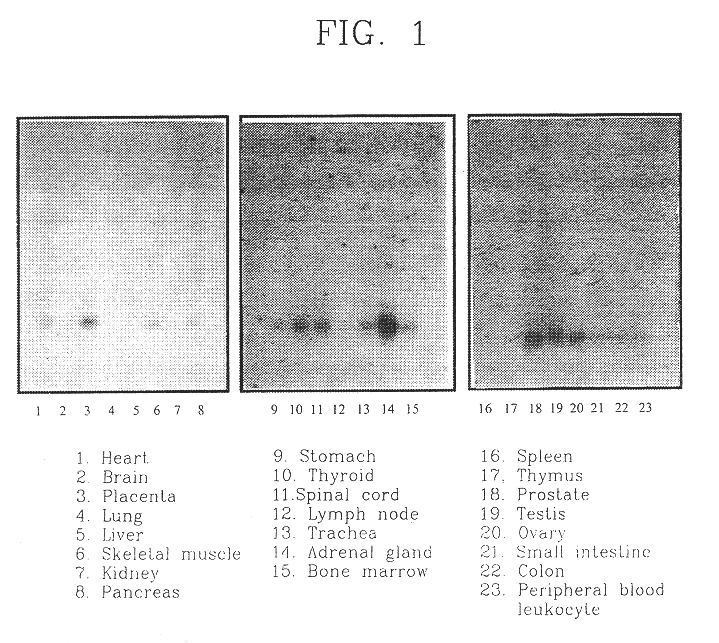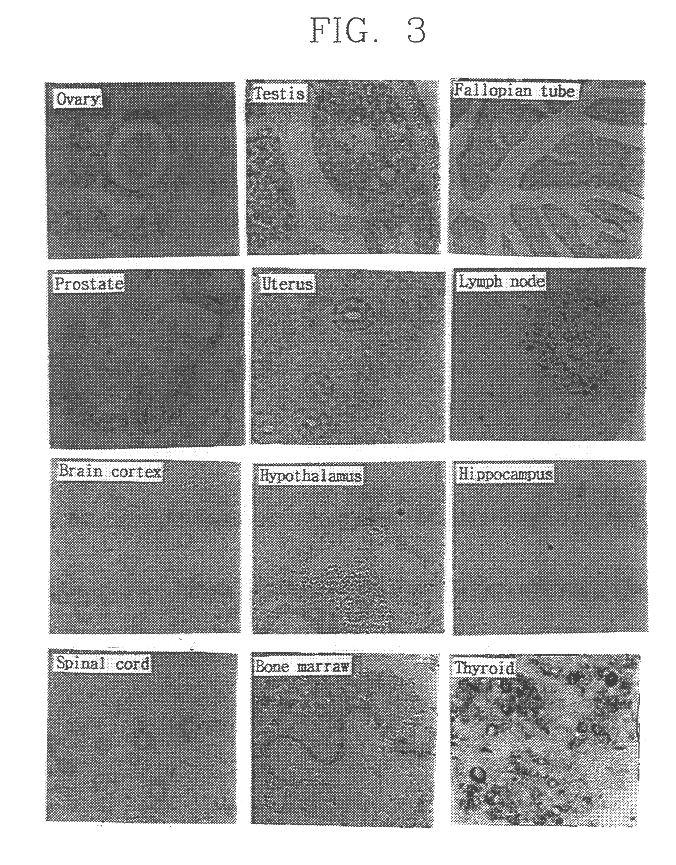Cell growth inhibiting and cell differentiation specific SYG972 gene, genomic DNA and promoter thereof
a technology of syg972 and syg972, which is applied in the field of cell growth inhibition and cell differentiation specific syg972 gene, genomic dna and promoter thereof, can solve the problems of abnormal cell growth and cancer cells
- Summary
- Abstract
- Description
- Claims
- Application Information
AI Technical Summary
Problems solved by technology
Method used
Image
Examples
example 2
Expression Behavior of SYG972 in Human Tissue
To investigate the level of expression of SYG972 in human tissue, total RNA was extracted from human tissue and analyzed by Northern blot hybridization (Sambrook, J. et. al. (1989). Molecular cloning: a laboratory manual. Cold Spring Harbor Laboratory Press). To a membrane (Clontech) blotted with extracted RNA from human tissue, SYG972 DNA probe marked with .alpha.-.sup.32 P-[dCTP] was hybridized and reacted for 24 hours and washed with 2.times.SSC, 0.1% SDS solution for 10 minutes at room temperature and for 30 minutes at 50.degree. C. The washed membrane was exposed at -70.degree. C. for 1 week on an x-ray film and developed. The result is shown in FIG. 1.
Expression of SYG972 varied for different tissues. Expression of SYG972 was observed in the heart, placenta, skeletal muscle, pancreas, gastrointestinal tract, thyroid, spinal cord, lymph node, trachea, adrenal, bone marrow, prostate, testis, ovary, small and large intestines. Among th...
example 3
Expression Behavior of SYG972 in Various Differentiation Models
To investigate the quantitative change of SYG972 mRNA during cell differentiation, three different cell differentiation models were used. PC12 cells which are pheochromocytoma, have a characteristic of differentiating to nerve cells by NGF (nerve growth factor), and C2C12 and L6 which are mouse myoblasts and white mouse myoblast respectively, have a tendency to differentiate to muscle cells by a stimulus inducing differentiation. PC12 cells were cultured in 10% horse serum (GibcoBRL) supplemented with 5% bovine fetal serum, 100 unit / ml penicillin G sodium and 100 .mu.g / ml streptomycin sulfate. To obtain RNA from differentiated PC12 cells, 50 ng / ml of NGF (Gibco BRL) was added in the medium. After a few hours, differentiated cell morphology was identified under microscope and collected at different time intervals.
C2C12 and L6 cells were cultured in 10% bovine fetal serum supplemented with 100 unit / ml penicillin G sodium a...
example 4
Expression of SYG972 in Mouse Tissue
SYG972 gene expression level was investigated by using in situ hybridization method developed by Braissant and co-workers (Braissant, O. et. al. (1996)). Differential expression of peroxisome proliferator-activated receptors (PPARs): tissue distribution of PPAR-.alpha., .beta., and -.gamma. in an adult rat. Endocrinology 137, 354-366). in other words, antisense-DIG SYG972 RNA probe was prepared by cutting pBluescript II vector containing SYG972 cDNA with EcoR I and treated with DIG-11UTP. Mouse tissue specimen for analysis was obtained from anaesthetized 5 week old mouse and fixed for 24 hours in 4% formaldehyde-PBS and dehydrated continuously in 70%, 95% and 100% Xylene. Dehydrated specimen was solidified in parablast, cut in 5 .mu.m width and adhered to ProbeOn plus slide (Fisher). Adhered specimen was hybridized with antisense probe after pre-treatment. Non-specifically bound probes were washed through post-treatment. To identify the probe in t...
PUM
| Property | Measurement | Unit |
|---|---|---|
| temperature | aaaaa | aaaaa |
| temperature | aaaaa | aaaaa |
| width | aaaaa | aaaaa |
Abstract
Description
Claims
Application Information
 Login to View More
Login to View More - R&D
- Intellectual Property
- Life Sciences
- Materials
- Tech Scout
- Unparalleled Data Quality
- Higher Quality Content
- 60% Fewer Hallucinations
Browse by: Latest US Patents, China's latest patents, Technical Efficacy Thesaurus, Application Domain, Technology Topic, Popular Technical Reports.
© 2025 PatSnap. All rights reserved.Legal|Privacy policy|Modern Slavery Act Transparency Statement|Sitemap|About US| Contact US: help@patsnap.com



